Attached files
| file | filename |
|---|---|
| 8-K - FORM 8-K - METLIFE INC | d450611d8k.htm |
| EX-99.2 - PRESS RELEASE OF METLIFE, INC., DATED DECEMBER 13, 2012 - METLIFE INC | d450611dex992.htm |
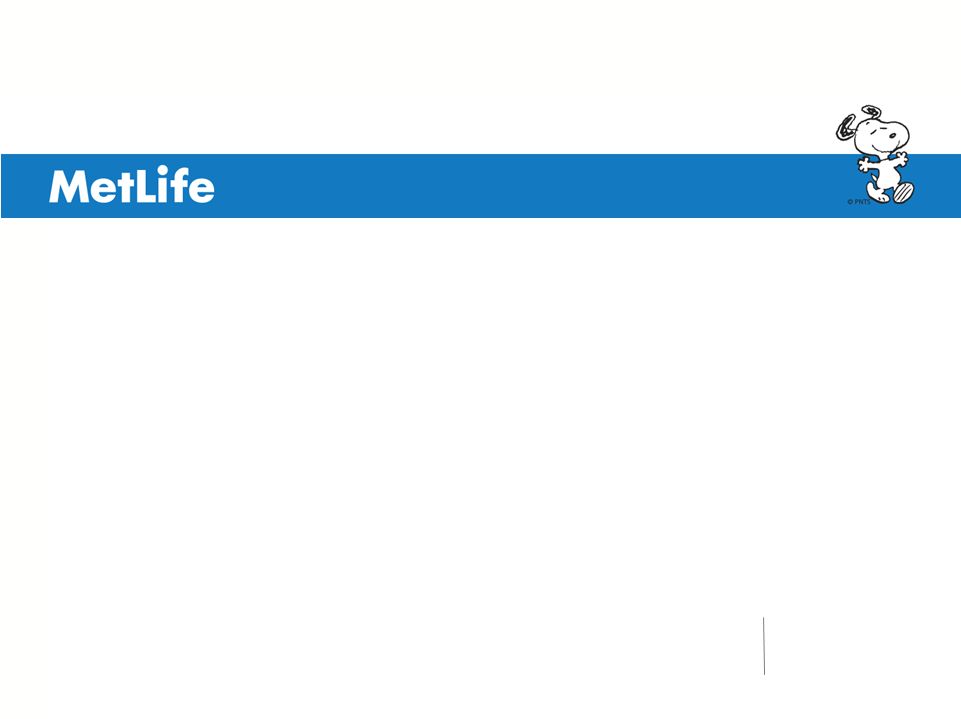 2 0 1
2 Agenda
GUIDANCE
PRESENTATION
Exhibit 99.1 |
 This presentation may contain or incorporate by reference forward-looking
statements. Forward-looking statements give expectations or forecasts of future events and
use words such as “anticipate,”
“estimate,”
“expect,”
“project”
and other terms of similar meaning. Any or all
forward-looking statements may turn out to be wrong, and
actual results could differ materially from those expressed or implied in the forward-looking statements.
Predictions of future performance are
inherently difficult and are subject to numerous risks and uncertainties, including
those identified in the “Risk Factors” section of MetLife,
Inc.’s filings with the U.S. Securities and Exchange Commission.
The company does not undertake any obligation to publicly correct or update any forward-looking statement if it later becomes
aware that such statement is not likely to be achieved. Additional discussion
of forward-looking statements may be included in other slides in this presentation; if so,
please refer to those slides for more information.
The presentation may also contain measures that are not calculated based on
accounting principles generally accepted in the United States of America, also known as
GAAP. Additional discussion of non-GAAP financial information may be
included in other slides in this presentation, on the Investor Relations portion of MetLife's
website (www.metlife.com), or elsewhere on that
website; if so, please refer to those slides or the website for more information.
Cautionary Statement on Forward Looking Statements and
Non-GAAP Financial Information
2 |
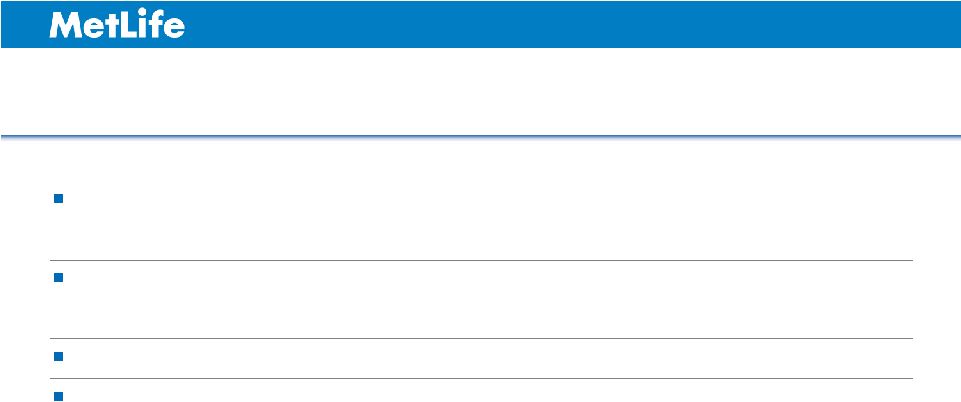 Agenda
Overview
Steven A. Kandarian
Chairman, President & Chief Executive Officer
Finance
John C.R. Hele
Chief Financial Officer
Q&A
Appendix
3 |
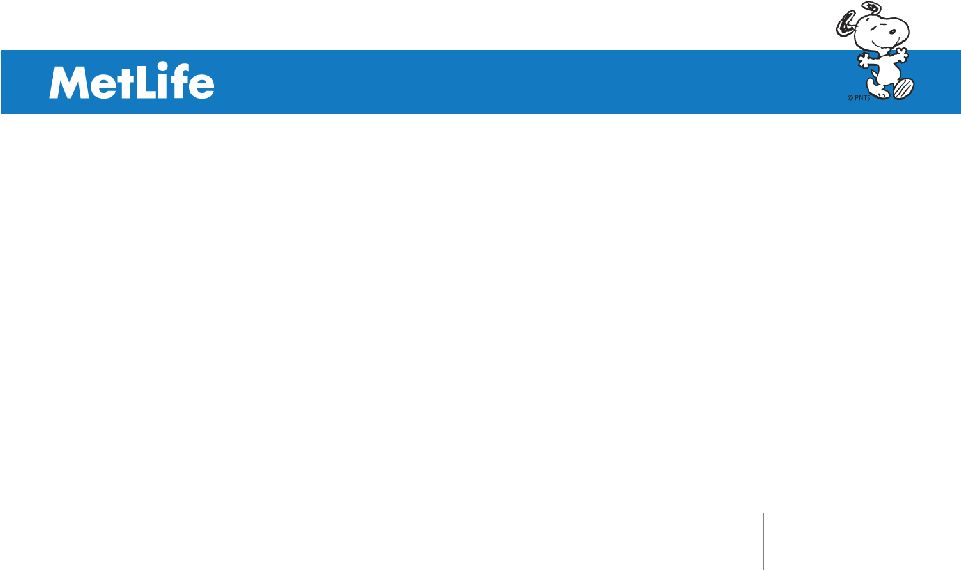 GUIDANCE PRESENTATION
2 0 1 2
Steven A. Kandarian
Chairman, President &
Chief Executive Officer |
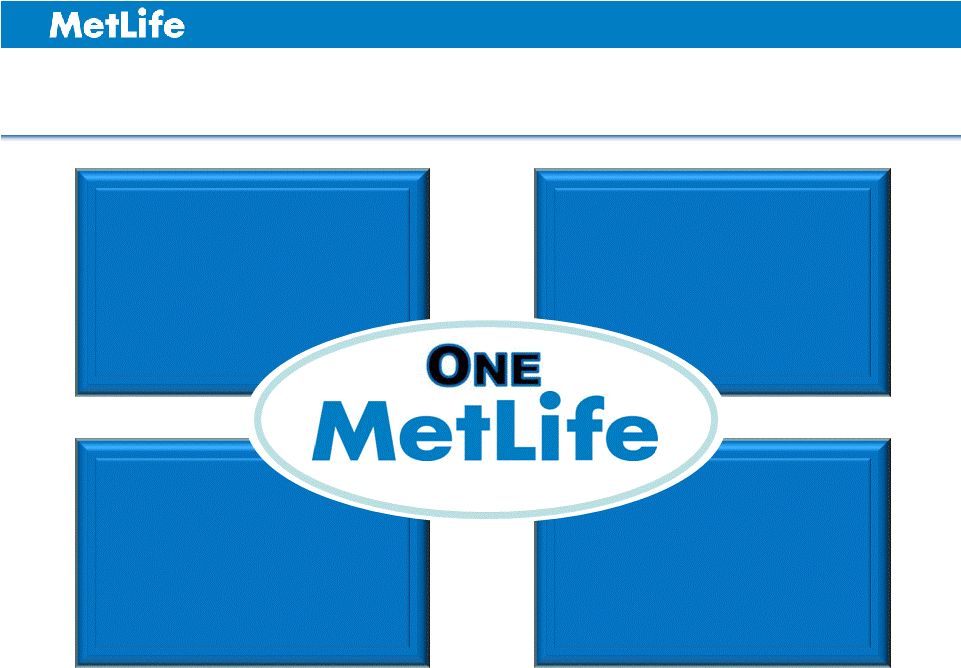 Strategy to Become a World-Class Company
5
Build Global
Employee Benefits
Business
Refocus the U.S.
Business
Grow
Emerging Markets
Drive Toward
Customer Centricity
and a Global Brand
G
LOBAL
*
W
ORLD
-C
LASS
*
S
CALE
|
 Full
Year 2012 Financial Overview 6
$4.80 -
$5.20
$4.03
3Q12
YTD
4Q12E
$1.12 -
$1.22
$5.15 -
$5.25
(Operating Earnings per Share)
2012 Plan
2012E
2012E
Normalized
2012 Plan vs Estimate
1
$5.22 -
$5.32
1
The bars represent mid-points of ranges.
See Appendix for non-GAAP financial information, definitions and/or
reconciliations. 4Q12 estimate reflects impact
from Superstorm Sandy
Investment spreads benefit
from variable investment
income & interest rate hedges
Improved underwriting
margins
Expenses remain under
control |
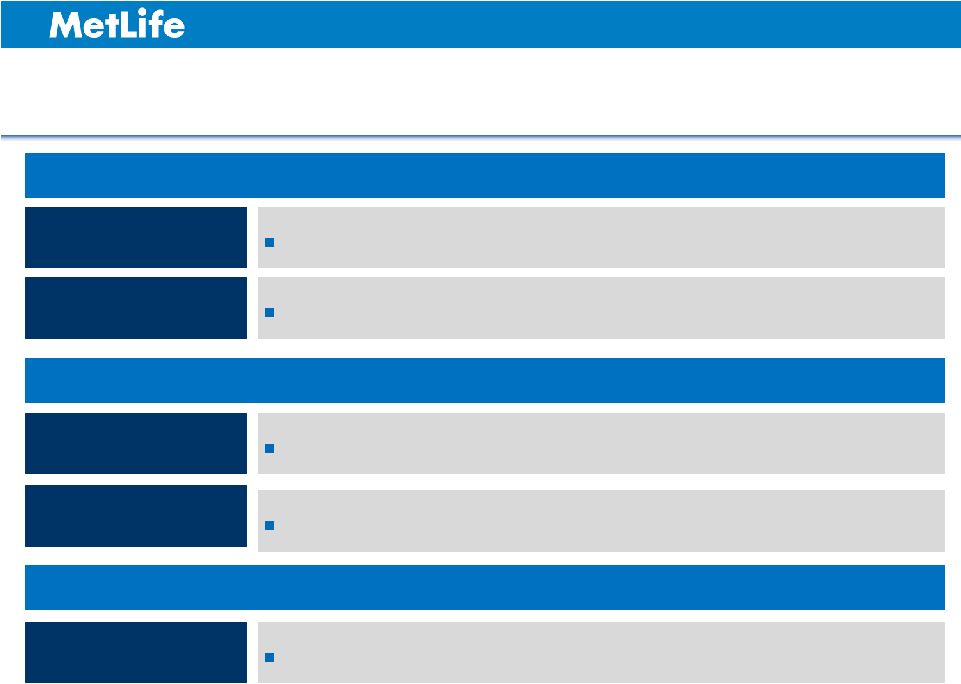 Mixed Global Economic Outlook
Europe
The Americas
Japan
Latin America
U.S.
Asia
EMEA
Asia (Ex-Japan)
Low interest rates, regulatory and fiscal uncertainty, modest recovery
Recession risk, increasing debt burden, high savings rate
Sustainable growth, contained inflation, continued progress
Cooling growth, moderate inflation, sound fiscal policy
Recession, fiscal contraction, structural reforms proposed
7 |
 Interest Rate Hedge Income Flat, Portfolio Yield Declines
Interest rate hedge income
is estimated to be flat next
year
Effect of low reinvestment
rates more evident in 2013
8
(Pre-tax $ in Millions)
1
Excludes Corporate & Other. 2012 Estimate and 2013 Plan represent
mid-points of ranges. 2
Portfolio yield includes interest rate hedge income.
2
$370
$537
$537
5.66%
5.57%
5.27%
2011
2012 Estimate
2013 Plan
Interest Rate Hedge Income
Portfolio Yield
U.S. Business
1 |
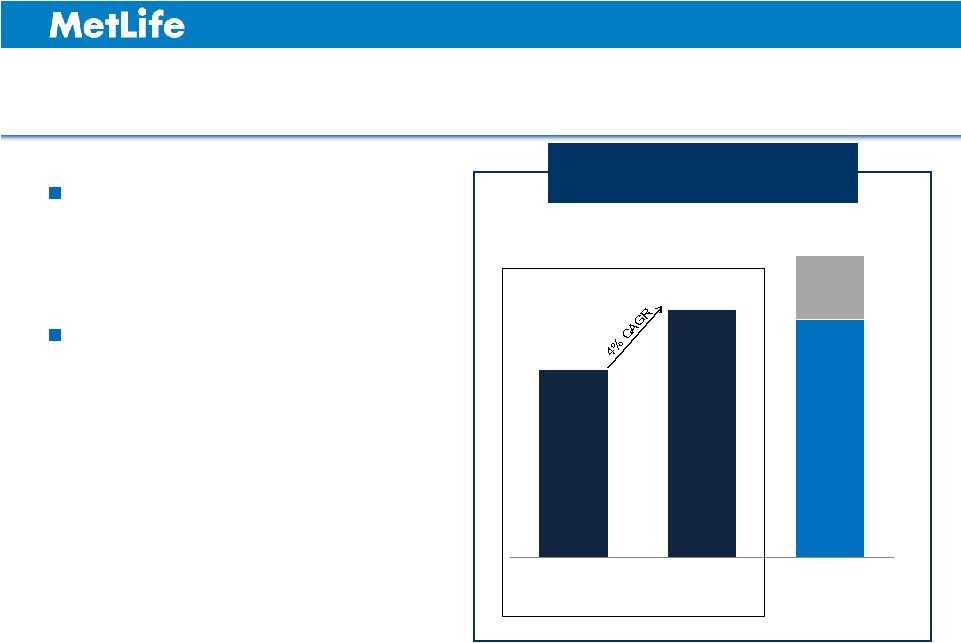 2013
Guidance Illustrates Resilience of Operating Earnings Low interest rate
impact is consistent with what we have
said previously
Still project operating earnings
growth over time even if rates
remain low
2011 Normalized
2013 Low Rate
Scenario
2013 Plan
Low Rates Reducing Operating
EPS Growth Rate as Expected
$4.95 -
$5.35
$5.07
2
$4.69
1
9
2
Represents a 4% compound annual growth rate, which is consistent with the hypothetical scenario
(presented in the 3Q11 Earnings Call Supplement available on the Investor Relations
portion of our Internet website (www.metlife.com)) where U.S. Treasury yields remain flat for five years.
See Appendix for non-GAAP financial information, definitions and/or reconciliations. 1
Number not adjusted for divestment of bank. Adjusting for the divestment, 2011 normalized
operating EPS is $4.61.
|
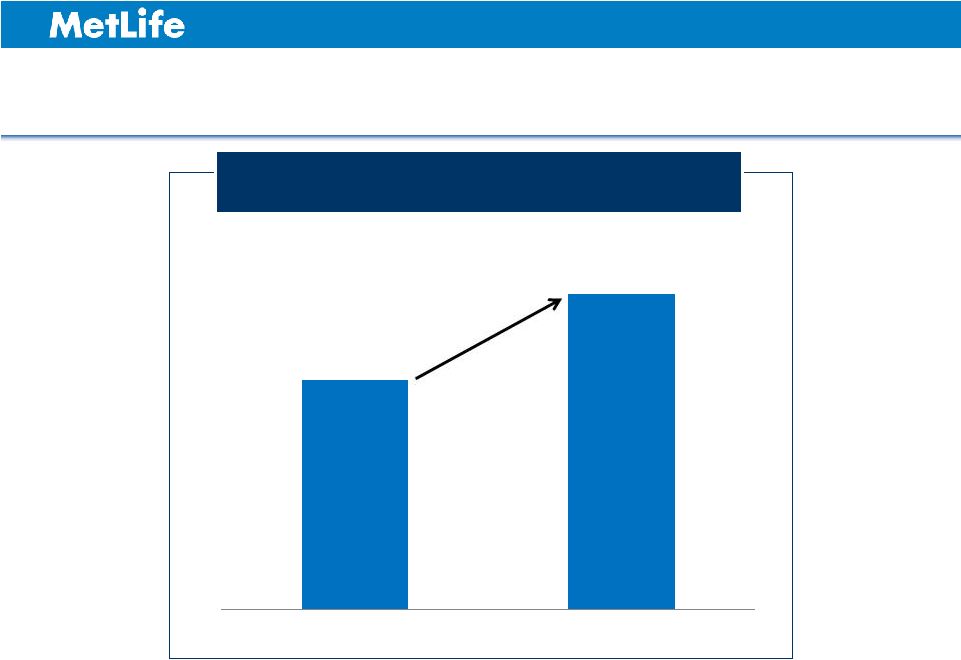 Expanding Operating ROE in a Challenging Environment
Expect to Achieve 12% Operating ROE
by 2016
Even if Interest Rates Remain Low
1
10
1
The bars represent mid-points of ranges.
See Appendix for non-GAAP financial information, definitions and/or
reconciliations. 12.0% -
14.0%
11.0% -
11.1%
2012 Estimate
2016 Target |
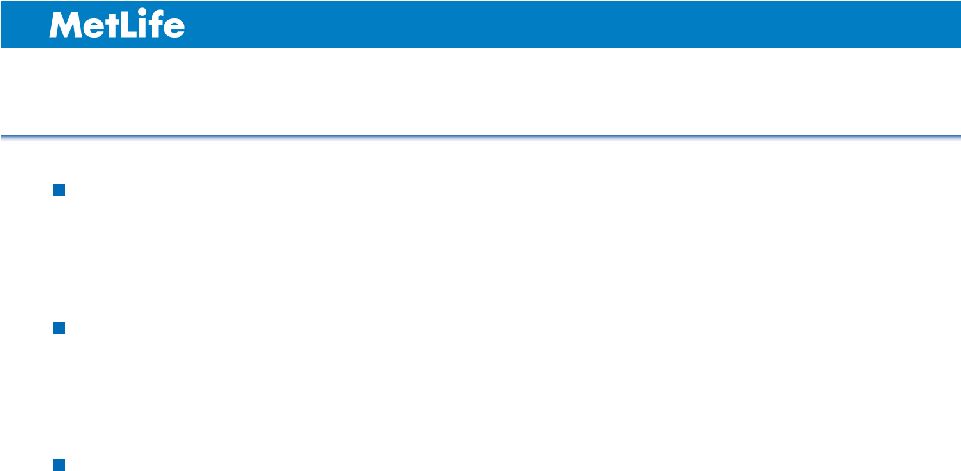 Upward Trend in EPS and Operating ROE Despite Low Rates
Growth in non-U.S. through 2016 should drive overall growth in
operating earnings even if low interest rates persist
Focused on what we can control, cost saves and strategic initiatives
expected to contribute 200 bps to operating ROE by 2016
Sense of urgency around strategic initiatives considering elevated risk
of lower-for-longer interest rate scenario
11
See Appendix for non-GAAP financial information, definitions and/or
reconciliations. |
 Base Case is Business Generates Excess Capital
Assuming regulatory capital rules reflect the insurance business
model, MetLife should generate excess capital
Shift from market sensitive to protection products improves our risk
profile and free cash flow
Goal is to increase free cash flow from approximately 40% of operating
earnings to at least 50% over time
We remain committed to returning capital to shareholders
12
See Appendix for non-GAAP financial information, definitions and/or
reconciliations. |
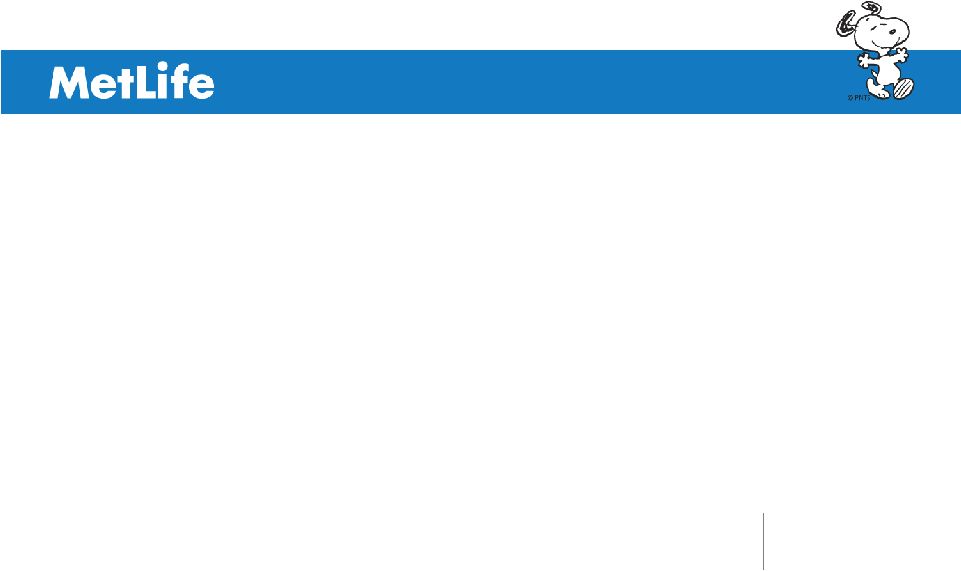 GUIDANCE PRESENTATION
2 0 1 2
John C. R. Hele
Executive Vice President &
Chief Financial Officer |
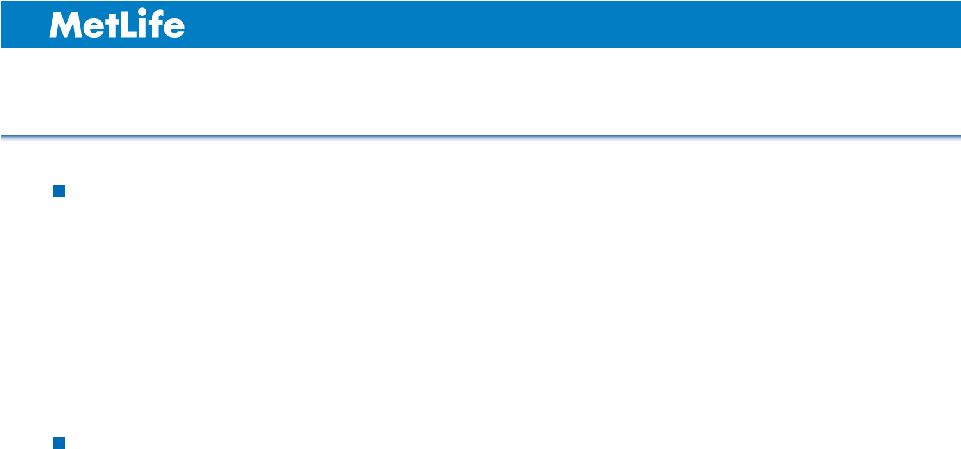 Agenda
Review of estimated results
–
Fourth quarter 2012
–
Full year 2012
Review of 2013 plan
14 |
 Fourth Quarter 2012 Estimate
See Appendix for non-GAAP financial information, definitions and/or
reconciliations. 15
($ in Millions, except per share data)
Operating Earnings
$1,215
-
$1,320
Operating Earnings per Share
1.12
$
-
1.22
$
PY Development/CATs
DAC and Other Assumption Items
Reorganization Costs
Variable Investment Income
Q4 2012 "Normalized" Operating EPS
1.19
$
-
1.29
$
DAC and Other
($750)
-
($550)
Net Investment Gains/(Losses)
($200)
-
($100)
Net Derivative Gains/(Losses)
($300)
-
$300
Book Value per Share (including AOCI)
$57.57
-
$58.01
Book Value per Share (excluding AOCI)
$46.97
-
$47.41
4th Quarter
0.06
0.01
(0.05)
0.05 |
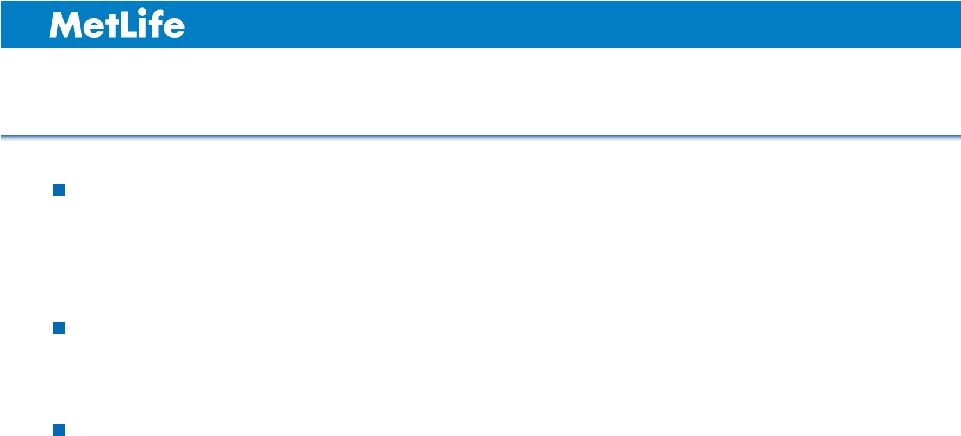 4Q12 DAC and Other Actuarial Assumptions Update
16
Projected
charge
of
$600
-
$800
million
after-tax
for
DAC
and
other
actuarial assumption updates
Reflects changes in variable annuity lapse rates
Includes changes to long-term fixed income returns
|
 Full Year 2012 Financial Overview
See Appendix for non-GAAP financial information, definitions and/or
reconciliations. ($ in Billions, except per share data)
17
2011
Actual
2012 Plan
2012 Estimate
Premiums,
Fees
&
Other
Revenues
(Operating)
$45.4
$47.3
-
$48.6
$47.3
-
$47.7
Operating Earnings
$4.7
$5.1
-
$5.6
$5.5
-
$5.6
Operating Earnings per Share
$4.38
$4.80
-
$5.20
$5.15
-
$5.25
Operating Expense Ratio
24.4%
23.9%
-
24.5%
23.9%
-
24.1%
Operating Return on Equity
10.1%
10.0%
-
10.6%
11.0%
-
11.1% |
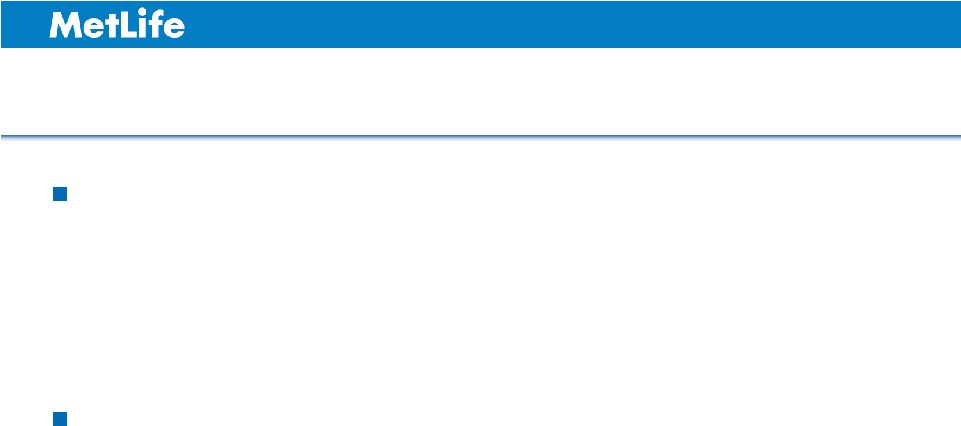 2012 MetLife Capital Position Year-End Estimate
Enterprise capital levels remain strong
–
Combined
U.S.
RBC
ratio
1
425%
-
450%
–
Japan
solvency
margin
ratio
(SMR)
800%
-
900%
–
$5.4 billion cash and liquid assets at holding companies
Moody’s
leverage
ratio
2
of
27.0%
1
2
18
Calculated based on the Company’s principal U.S. insurance subsidiaries,
excluding American Life Insurance Company. Reported leverage includes 3Q12 AOCI held constant,
and $400 million maturing senior note repayment in December 2012. |
 2013 Plan Assumptions
5% annual S&P 500 Index growth
–
S&P 500 Index of 1,422 as of Dec. 31, 2012
U.S interest rates based on consensus
–
10 year at 1.65% at Dec. 31, 2012 going to 2.38% at Dec. 31, 2013
Exchange rates at consensus
–
Yen/$ at 79 at Dec. 31, 2012; 84 at Dec. 31, 2013
No stock buybacks assumed
Effective corporate tax rate of 28.5%
19 |
  2013
Plan ($ in Millions, except per share data)
See Appendix for non-GAAP financial information, definitions and/or
reconciliations. 20
Operating Earnings
$5,500
-
$5,940
Average Shares Outstanding (in Millions)
Operating Earnings per Share
4.95
$
-
5.35
$
Operating Expense Ratio
23.6%
-
24.5%
Net Investment Gains/(Losses)
($600)
-
($200)
Book Value per Share (excluding AOCI)
50.48
$
-
51.66
$
Operating Return on Equity
10.2%
-
10.9%
1,110.4
2013 Plan |
 Variable Investment Income Outlook
Alternative Investments
Real Estate Funds
and Other Joint Ventures
Prepayments
($ in Millions)
Variable Investment Income Plan
$800M to $1.2B for 2013
21
Range
0
200
400
600
800
1,000
1,200
1,400
2012 Plan
2012 Estimate
2013 Plan
$ |
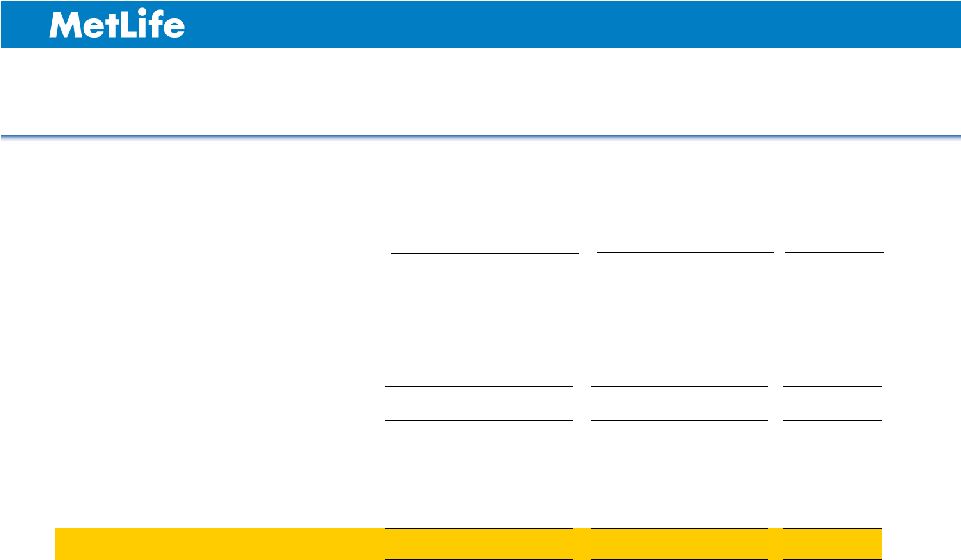 2013 Operating Earnings by Line of Business
($ in Millions)
1
Calculated using mid-point of ranges before rounding.
See Appendix for non-GAAP financial information, definitions and/or
reconciliations. 22
Growth Rate
1
Retail
$1,860
-
$1,910
$1,910
-
$2,010
4.0%
Group, Voluntary & Worksite Benefits
990
-
1,000
995
-
1,055
3.0%
Corporate Benefit Funding
1,160
-
1,170
1,095
-
1,155
(3.4%)
Latin America
580
-
590
560
-
620
0.9%
The Americas
4,590
-
4,670
4,560
-
4,840
1.5%
Asia
1,075
-
1,090
1,130
-
1,230
8.9%
EMEA
250
-
260
250
-
290
5.7%
Corporate & Other
(310)
-
(310)
(440)
-
(420)
nm
Total
$5,605
-
$5,710
$5,500
-
$5,940
1.1%
2012 Normalized
Estimate
2013 Plan |
 2013 Cash
and Liquid Assets Estimate at Holding Companies
Holding Companies Cash Roll Forward
1
($ in Billions)
2012E
Subsidiary Dividends
Mandatory
Equity Units
Expenses
and Other
Current Common
Dividend and
Debt Maturity
2013 Cash and Liquid
Assets Before
Incremental
Capital Actions
$5.4
$3.0 -
$3.5
$1.0
($1.6)
$4.8 -
$5.8
23
($2.5 -
$3.0)
1
2013 cash and liquid assets is prior to incremental capital actions such as M&A, common stock
buybacks and common stock dividend increase. The bars represent mid-points of
ranges. |
 Targeting more than a 40%
decline in VA sales for 2013
Continued movement toward
lower-risk product design and
rationalizing distribution
Consistent with strategy to
shift mix toward less capital-
intensive products
Managing Variable Annuity Risk
24
1
Statutory premiums, direct and assumed, excluding company sponsored internal
exchanges. ($ in Billions)
MetLife
U.S.
Variable
Annuity
Sales
1
$15.3
$13.9
$15.4
$18.3
$28.4
2007
2008
2009
2010
2011
2012E
2013P
$17.5 -
$18.5
$10.0 -
$11.0 |
 Key
Takeaways 2012 was a good year with operating earnings growth expected to be
in a range of 18% to 20%
2013 looks challenging, but still see double-digit operating ROE
despite no assumption for capital management
Focused on risk reduction and improving free cash flow
Well positioned to manage in tough environment
No material change in long-term outlook
25
See Appendix for non-GAAP financial information, definitions and/or
reconciliations. |
 |
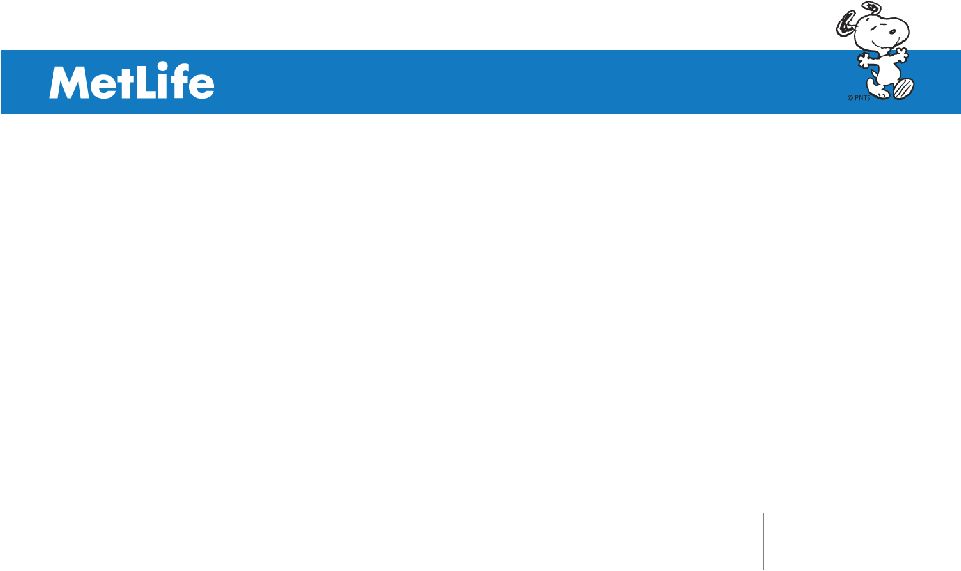 Appendix
2 0 1 2
GUIDANCE PRESENTATION |
 Safe Harbor Statement
28
These materials may contain or incorporate by reference information that includes or is based upon
forward-looking statements within the meaning of the Private Securities Litigation Reform
Act of 1995. Forward-looking statements give expectations or forecasts of future events. These statements can be identified by the fact
that they do not relate strictly to historical or current facts. They use words such as
“anticipate,” “estimate,” “expect,” “project,” “intend,” “plan,” “believe” and other words
and terms of similar meaning in connection with a discussion of future operating or financial
performance. In particular, these include statements relating to future actions, prospective
services or products, future performance or results of current and anticipated services or products, sales efforts, expenses, the outcome of
contingencies such as legal proceedings, trends in operations and financial results. Any or all
forward-looking statements may turn out to be wrong. They can be affected by inaccurate assumptions or by known or unknown risks and uncertainties.
Many such factors will be important in determining the actual future results of MetLife, Inc., its
subsidiaries and affiliates. These statements are based on current expectations and the current
economic environment. They involve a number of risks and uncertainties that are difficult to predict. These statements are not guarantees
of future performance. Actual results could differ materially from those expressed or implied in the
forward-looking statements. Risks, uncertainties, and other factors that might cause such
differences include the risks, uncertainties and other factors identified in MetLife, Inc.’s filings with the U.S. Securities and Exchange
Commission (the “SEC”). These factors include: (1) difficult conditions in the global
capital markets; (2) concerns over U.S. fiscal policy and the “fiscal cliff” in the U.S.,
as well as rating agency downgrades of U.S. Treasury securities; (3) uncertainty about the
effectiveness of governmental and regulatory actions to stabilize the financial system, the
imposition of fees relating thereto, or the promulgation of additional regulations; (4) increased volatility and disruption of the capital
and credit markets, which may affect our ability to seek financing or access our credit facilities;
(5) impact of comprehensive financial services regulation reform on us; (6) economic,
political, legal, currency and other risks relating to our international operations, including with respect to fluctuations of exchange rates; (7) exposure to
financial and capital market risk, including as a result of the disruption in Europe and possible
withdrawal of one or more countries from the Euro zone; (8) changes in general economic
conditions, including the performance of financial markets and interest rates, which may affect our ability to raise capital, generate fee income and
market-related revenue and finance statutory reserve requirements and may require us to pledge
collateral or make payments related to declines in value of specified assets; (9) potential
liquidity and other risks resulting from our participation in a securities lending program and other transactions; (10) investment losses and defaults,
and changes to investment valuations; (11) impairments of goodwill and realized losses or market value
impairments to illiquid assets; (12) defaults on our mortgage loans; (13) the defaults or
deteriorating credit of other financial institutions that could adversely affect us; (14) our ability to address unforeseen liabilities, asset
impairments, or rating actions arising from acquisitions or dispositions, including our acquisition of
American Life Insurance Company and Delaware American Life Insurance Company (collectively,
“ALICO”) and to successfully integrate and manage the growth of acquired businesses with minimal disruption; (15) uncertainty with
respect to the outcome of the closing agreement entered into with the United States Internal Revenue
Service in connection with the acquisition of ALICO; (16) the dilutive impact on our
stockholders resulting from the settlement of common equity units issued in connection with the acquisition of ALICO or otherwise; (17)
regulatory and other restrictions affecting MetLife, Inc.’s ability to pay dividends and
repurchase common stock; (18) MetLife, Inc.’s primary reliance, as a holding company, on
dividends from its subsidiaries to meet debt payment obligations and the applicable regulatory restrictions on the ability of the subsidiaries to pay such
dividends; (19) downgrades in our claims paying ability, financial strength or credit ratings; (20)
ineffectiveness of risk management policies and procedures; (21) availability and effectiveness
of reinsurance or indemnification arrangements, as well as default or failure of counterparties to perform; (22) discrepancies between
actual claims experience and assumptions used in setting prices for our products and establishing the
liabilities for our obligations for future policy benefits and claims; (23) catastrophe losses;
(24) heightened competition, including with respect to pricing, entry of new competitors, consolidation of distributors, the development of new
products by new and existing competitors, distribution of amounts available under U.S. government
programs, and for personnel; (25) unanticipated changes in industry trends; (26) changes in
assumptions related to investment valuations, deferred policy acquisition costs, deferred sales inducements, value of business
acquired or goodwill; (27) changes in accounting standards, practices and/or policies; (28) increased
expenses relating to pension and postretirement benefit plans, as well as health care and other
employee benefits; (29) exposure to losses related to variable annuity guarantee benefits, |
 Safe Harbor Statement (Continued)
29
including from significant and sustained downturns or extreme volatility in equity markets, reduced
interest rates, unanticipated policyholder behavior, mortality or longevity, and the adjustment
for nonperformance risk; (30) deterioration in the experience of the “closed block” established in connection with the reorganization
of Metropolitan Life Insurance Company; (31) adverse results or other consequences from litigation,
arbitration or regulatory investigations; (32) inability to protect our intellectual property
rights or claims of infringement of the intellectual property rights of others; (33) discrepancies between actual experience and assumptions
used in establishing liabilities related to other contingencies or obligations; (34) regulatory,
legislative or tax changes relating to our insurance, banking, international, or other
operations that may affect the cost of, or demand for, our products or services, or increase the cost or administrative burdens of providing
benefits to employees; (35) the effects of business disruption or economic contraction due to
disasters such as terrorist attacks, cyberattacks, other hostilities, or natural catastrophes,
including any related impact on our disaster recovery systems, cyber- or other information security systems and management continuity
planning; (36) the effectiveness of our programs and practices in avoiding giving our associates
incentives to take excessive risks; and (37) other risks and uncertainties described from time
to time in MetLife, Inc.’s filings with the SEC.
MetLife, Inc. does not undertake any obligation to publicly correct or update any forward-looking
statement if MetLife, Inc. later becomes aware that such statement is not likely to be
achieved. Please consult any further disclosures MetLife, Inc. makes on related subjects in reports to the SEC.
. |
 Explanatory Note on Non-GAAP Financial Information
All references in this presentation (except in this Explanatory Note on
Non-GAAP Financial Information slide and the Appendix) to net income
(loss), net income (loss) per share, operating earnings, operating earnings per
share, book value per common share, premiums, fees and other revenues and
operating return on equity, should be read as net income (loss) available to MetLife, Inc.'s common shareholders, net income
(loss) available to MetLife, Inc.'s common shareholders per diluted common share,
operating earnings available to common shareholders, operating
earnings
available
to
common
shareholders
per
diluted
common
share,
book
value
per
common
share,
excluding
accumulated
other
comprehensive income (loss) ("AOCI"), premiums, fees and other revenues
(operating) and operating return on MetLife, Inc.’s common equity,
excluding AOCI, respectively.
Operating
earnings
is
the
measure
of
segment
profit
or
loss
that
MetLife
uses
to
evaluate
segment
performance
and
allocate
resources.
Consistent with accounting principles generally accepted in the United States of
America ("GAAP") accounting guidance for segment reporting,
operating
earnings
is
MetLife's
measure
of
segment
performance.
Operating
earnings
is
also
a
measure
by
which
MetLife
senior
management's and many other employees' performance is evaluated for the purposes of
determining their compensation under applicable compensation plans.
Operating earnings is defined as operating revenues less operating expenses, both
net of income tax. Operating earnings available to common shareholders
is defined as operating earnings less preferred stock dividends.
Operating
revenues
and
operating
expenses
exclude
results
of
discontinued
operations
and
other
businesses
that
have
been
or
will
be
sold
or
exited by MetLife, Inc. (“Divested Businesses”). Operating revenues
also excludes net investment gains (losses) (“NIGL”) and net derivative
gains (losses) (“NDGL”). Operating expenses also excludes goodwill
impairments. The following additional adjustments are made to GAAP revenues,
in the line items indicated, in calculating operating revenues: •
Universal life and investment-type product policy fees excludes the
amortization of unearned revenue related to NIGL and NDGL and certain
variable annuity guaranteed minimum income benefits ("GMIB") fees
("GMIB Fees"); •
Net investment income: (i) includes amounts for scheduled periodic settlement
payments and amortization of premium on derivatives that are hedges of
investments but do not qualify for hedge accounting treatment, (ii) includes income from discontinued real estate operations,
(iii) excludes post-tax operating earnings adjustments relating to insurance
joint ventures accounted for under the equity method, (iv) excludes certain
amounts related to contractholder-directed unit-linked investments, and (v) excludes certain amounts related to
securitization entities that are variable interest entities ("VIEs")
consolidated under GAAP; and •
Other revenues are adjusted for settlements of foreign currency earnings hedges.
30 |
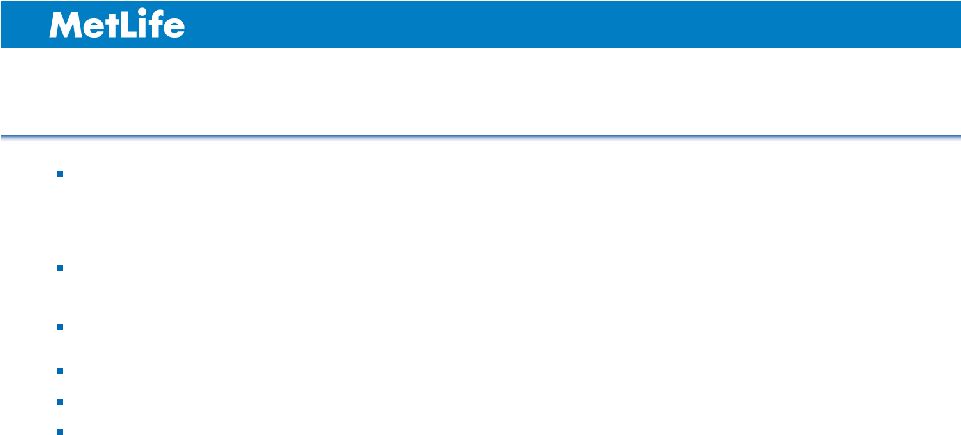 The following additional adjustments are made to GAAP expenses, in the line items
indicated, in calculating operating expenses: Policyholder benefits and
claims and policyholder dividends excludes: (i) changes in the policyholder dividend obligation related to NIGL and
NDGL, (ii) inflation-indexed benefit adjustments associated with contracts
backed by inflation-indexed investments and amounts associated with
periodic crediting rate adjustments based on the total return of a contractually referenced pool of assets, (iii) benefits and hedging costs
related to GMIBs ("GMIB Costs"), and (iv) market value adjustments
associated with surrenders or terminations of contracts ("Market Value
Adjustments");
Interest credited to policyholder account balances includes adjustments for
scheduled periodic settlement payments and amortization of premium on
derivatives that are hedges of policyholder account balances but do not qualify for hedge accounting treatment and excludes
amounts related to net investment income earned on contractholder-directed
unit-linked investments; Amortization of deferred policy acquisition
costs (“DAC”) and value of business acquired ("VOBA") excludes amounts related to: (i) NIGL and
NDGL, (ii) GMIB Fees and GMIB Costs, and (iii) Market Value Adjustments;
Amortization
of
negative
VOBA
excludes
amounts
related
to
Market
Value
Adjustments;
Interest expense on debt excludes certain amounts related to securitization
entities that are VIEs consolidated under GAAP; and Other expenses excludes
costs related to: (i) noncontrolling interests, (ii) implementation of new insurance regulatory requirements, and (iii)
acquisition and integration costs.
Operating return on MetLife, Inc.'s common equity is defined as operating earnings
available to common shareholders divided by average GAAP common
equity. Operating expense ratio is calculated by dividing operating expenses
(other expenses net of capitalization of DAC) by premiums, fees and other
revenues (operating).
MetLife believes the presentation of operating earnings and operating earnings
available to common shareholders as MetLife measures it for management
purposes enhances the understanding of the company's performance by highlighting the results of operations and the underlying
profitability
drivers
of
the
business.
Operating
revenues,
operating
expenses,
operating
earnings,
operating
earnings
available
to
common
shareholders, operating earnings available to common shareholders per diluted
common share, book value per common share, excluding AOCI, book value per
diluted common share, excluding AOCI, operating return on MetLife, Inc.’s common equity, operating return on MetLife, Inc.’s
common equity, excluding AOCI, investment portfolio gains (losses) and derivative
gains (losses) should not be viewed as substitutes for the following
financial
measures
calculated
in
accordance
with
GAAP:
GAAP
revenues,
GAAP
expenses,
GAAP
income
(loss)
from
continuing
operations, net of income tax, GAAP net income (loss) available to MetLife, Inc.'s
common shareholders, GAAP net income (loss) available to MetLife, Inc.'s
common shareholders per diluted common share, book value per common share, book value per diluted common share, return on
MetLife, Inc.’s common equity, return on MetLife, Inc.’s common equity,
excluding AOCI, net investment gains (losses) and net derivative gains
(losses), respectively.
Explanatory Note on Non-GAAP Financial Information
(Continued)
31 |
 Explanatory Note on Non-GAAP Financial Information
(Continued)
32
For the historical periods presented, reconciliations of non-GAAP measures used in this
presentation to the most directly comparable GAAP measures may be included in an Appendix to
the presentation materials and/or are on the Investor Relations portion of our Internet website.
Additional information about our historical results is also available on our Internet website in our
Quarterly Financial Supplements for the corresponding periods. Managed Assets (as
defined below) is a financial measure based on methodologies other than GAAP. MetLife utilizes “Managed Assets” to
describe assets in its investment portfolio which are actively managed and reflected at estimated fair
value. MetLife believes the use of Managed Assets enhances the understanding and
comparability of its investment portfolio by excluding assets such as policy loans, other invested assets,
mortgage loans held-for-sale, and mortgage loans held by consolidated securitization entities,
as substantially all of those assets are not actively managed in MetLife’s investment
portfolio. Trading and other securities are also excluded as this amount is primarily comprised of contractholder-
directed unit-linked investments, where the contractholder, and not the company, directs the
investment of these funds. Mortgage loans and certain real estate investments have also been
adjusted from carrying value to estimated fair value.
The non-GAAP measures used in this presentation should not be viewed as substitutes for the most
directly comparable GAAP measures.
In this presentation, we may refer to sales activity for various products. These sales statistics do
not correspond to revenues under GAAP, but are used as relevant measures of business
activity.
The impact of changes in foreign currency exchange rates is calculated using the average foreign
currency exchange rates for the current period and is applied to the prior period. In this
presentation, we may provide guidance on our future earnings, premiums, fees and other revenues, earnings per diluted common share,
book value per common share and return on common equity on an operating or non-GAAP
basis. A reconciliation of the non-GAAP measures to the most directly comparable GAAP
measures is not accessible on a forward-looking basis because we believe it is not possible to provide other
than a range of net investment gains and losses and net derivative gains and losses, which can
fluctuate significantly within or without the range and from period to period and may have a
significant impact on GAAP net income.
|
 Reconciliations
2 0 1 2
GUIDANCE PRESENTATION |
 Reconciliation of Operating Earnings Available to Common Shareholders to
Income (Loss) from Continuing Operations, Net of Income Tax
34
($ in Millions, except per share data)
2011
3Q12 YTD
Operating earnings available to common shareholders
4,677
4,313
Add: Preferred stock dividends
122
91
Operating earnings
4,799
4,404
Adjustments from operating earnings to income (loss) from continuing operations,
net of income tax: Add: Net investment gains (losses)
(867)
(152)
Add: Net derivative gains (losses)
4,824
(604)
Add: Goodwill impairment
-
(1,868)
Add: Other adjustments to continuing operations
(1,451)
(1,619)
Add: Provision for income tax (expense) benefit
(914)
1,048
Income (loss) from continuing operations, net of income tax
6,391
1,209
$
Operating earnings available to common shareholders per diluted common share
4.38
4.03
Add: Preferred stock dividends
0.11
0.09
Operating earnings per diluted common share
4.49
4.12
Adjustments from operating earnings per diluted common share
to income (loss) from continuing operations, net of income tax per diluted common
share: Add: Net investment gains (losses)
(0.81)
(0.14)
Add: Net derivative gains (losses)
4.52
(0.57)
Add: Goodwill impairment
-
(1.75)
Add: Other adjustments to continuing operations
(1.36)
(1.51)
Add: Provision for income tax (expense) benefit
(0.86)
0.98
Income (loss) from continuing operations, net of income tax per diluted common
share 5.98
$
1.13
$
1,068.1
1,070.0
Weighted
Average
Shares
Outstanding -
Diluted
$
$
$
$
$
$
$
$
$ |
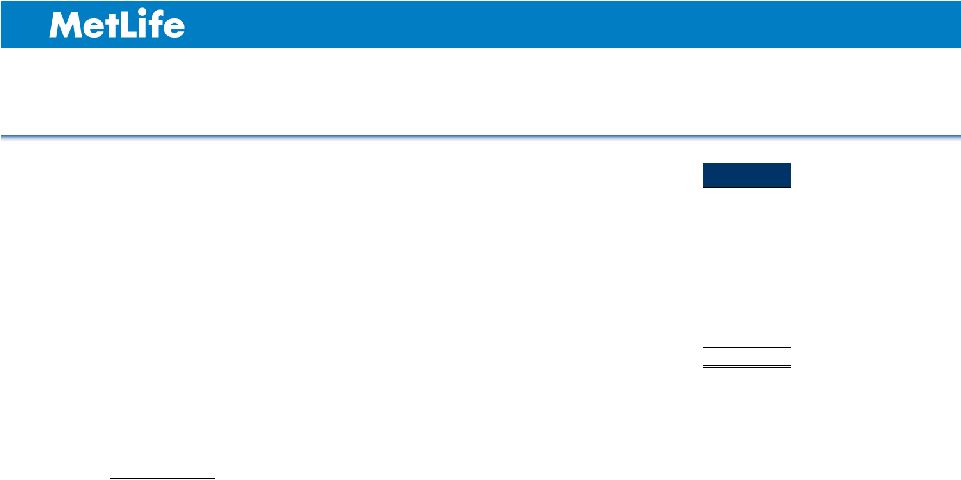 Reconciliation of Premiums, Fees & Other Revenues (Operating) to
Premiums,
Fees & Other Revenues (GAAP) and Calculation of Operating Expense Ratio
35
($ in Millions)
2011
Premiums, fees & other revenues (operating)
45,449
$
Adjustments from premiums, fees & other revenues (operating) to
premiums, fees & other revenues (GAAP):
Add: Premiums
92
Add: Universal life and investment-type product policy fees
278
Add: Other revenues
880
Premiums, fees & other revenues (GAAP)
46,699
$
Operating expenses
(1)
11,071
$
Operating expense ratio
24.4%
(1) Other expenses (operating) net of capitalization of DAC.
|
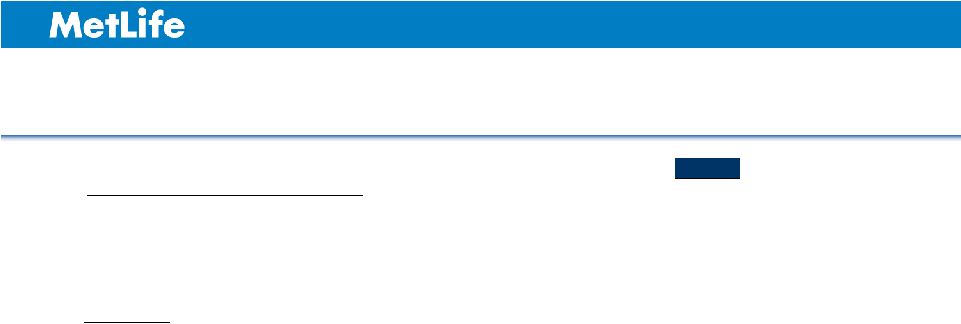 Reconciliation of Return on Common Equity
36
2011
Return on MetLife, Inc.'s Common Equity (1)
Return on MetLife, Inc.'s common equity (2)
12.2%
Return on MetLife, Inc.'s common equity, excluding AOCI (2)
13.2%
Operating return on MetLife, Inc.'s common equity (3)
9.3%
Operating return on MetLife, Inc.'s common equity, excluding AOCI (3)
10.1%
(1) Annualized using year-to date results.
(2) Return on MetLife, Inc.'s common equity is defined as net income available to common shareholders
divided by average GAAP common equity. (3) Operating return on MetLife, Inc.'s common
equity is defined as operating earnings available to common shareholders divided by average GAAP common equity. |
 Outlook
2 0 1 2
GUIDANCE PRESENTATION |
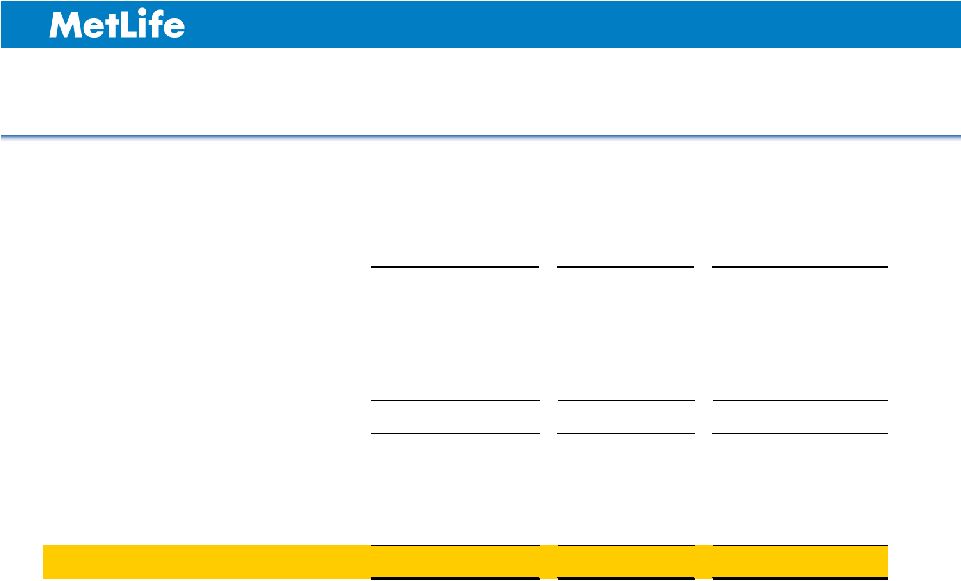 2012 Normalized Operating Earnings
($ in Millions)
38
Normalized
Adjustments
1
Retail
$1,875
-
$1,925
($15)
$1,860
-
$1,910
Group, Voluntary & Worksite Benefits
955
-
965
34
990
-
1,000
Corporate Benefit Funding
1,195
-
1,205
(37)
1,160
-
1,170
Latin America
580
-
590
0
580
-
590
The Americas
4,605
-
4,685
(18)
4,590
-
4,670
Asia
1,060
-
1,075
14
1,075
-
1,090
EMEA
265
-
275
(12)
250
-
260
Corporate & Other
(400)
-
(400)
87
(310)
-
(310)
Total
$5,530
-
$5,635
$71
$5,605
-
$5,710
2012 Estimate
2012 Normalized
Estimate
1
See “2012 Schedule of Normalized Adjustments” elsewhere in this Appendix.
See “Explanatory Note on Non-GAAP Financial Information” elsewhere in this
Appendix. |
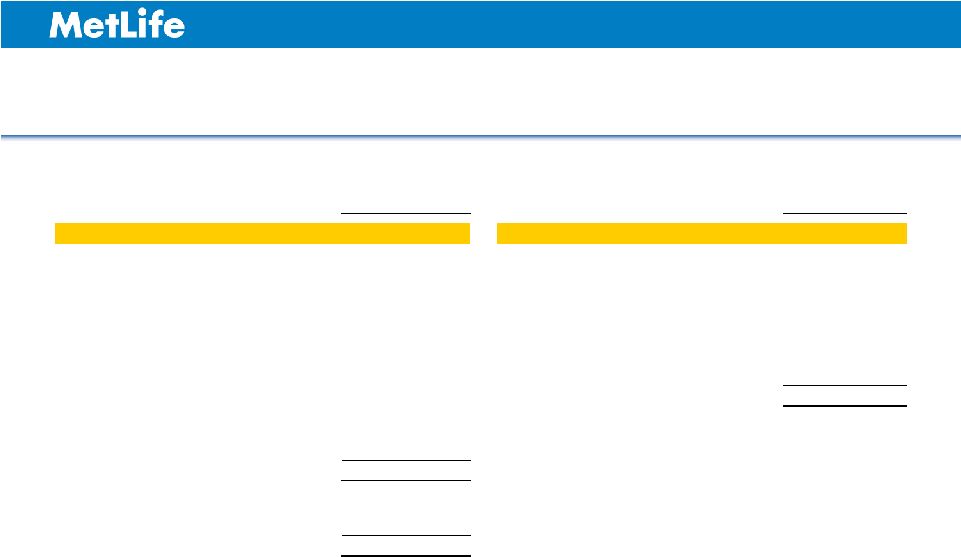 Normalized Operating Earnings Per Share
39
Operating Earnings per Share
Operating Earnings per Share
$5.15
-
5.25
$
Variable Investment Income
Variable Investment Income
Prior Year Development/CATS
Prior Year Development/CATS
DAC & Other
DAC & Other
Reserve Adjustments
Reorganization Costs
Japan Earthquake
Other
Japan Re Market
ELNY Liquidation
"Normalized" Operating EPS
$5.22
-
5.32
$
Alico Integration
Other
"Normalized" Operating EPS
MetLife Bank Divested Business
"Normalized" Operating EPS
0.08
$4.69
0.05
0.02
0.03
0.04
0.05
(0.02)
$4.61
2012 Estimate
(0.12)
0.04
0.08
2011
(0.13)
0.14
(0.03)
0.11
0.04
$4.38
See “Explanatory Note on Non-GAAP Financial Information” elsewhere in this
Appendix. |
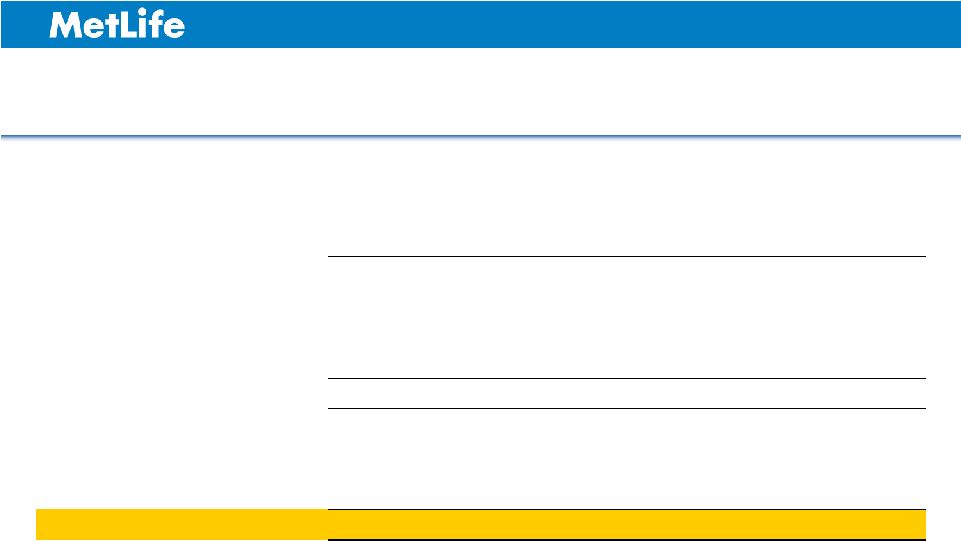 2012 Schedule of Normalized Adjustments
40
Variable
Investment
Income
Prior Year
Development/
CATS
DAC & Other
Reorganization
Costs
Other
Normalized
Adjustments
Retail
($9)
$28
($60)
$0
$26
($15)
Group, Voluntary & Worksite Benefits
0
12
22
0
0
34
Corporate Benefit Funding
(37)
0
0
0
0
(37)
Latin America
0
0
0
0
0
0
The Americas
(46)
40
(38)
0
26
(18)
Asia
(28)
0
37
0
5
14
EMEA
0
0
0
0
(12)
(12)
Corporate & Other
(57)
0
50
82
12
87
Total
($131)
$40
$49
$82
$31
$71
See “Explanatory Note on Non-GAAP Financial Information” elsewhere in this
Appendix. |
 2013
Premiums,
Fees
&
Other
Revenues
1
Growth
($ in Billions)
1
Operating.
2
Calculated using mid-point of ranges before rounding.
41
Growth Rate
Retail
$11.9
-
$12.0
$12.1
-
$12.5
2.8%
Group, Voluntary & Worksite Benefits
15.8
-
15.9
16.3
-
16.8
4.6%
Corporate Benefit Funding
3.5
-
3.6
2.7
-
2.9
(22.1%)
Latin America
3.4
-
3.4
3.7
-
3.9
10.6%
The Americas
34.6
-
34.9
34.8
-
36.1
1.8%
Asia
9.7
-
9.8
10.1
-
10.3
4.0%
EMEA
2.8
-
2.8
2.7
-
2.8
(2.0%)
Corporate & Other
0.2
-
0.2
0.3
-
0.5
nm
Total
$47.3
-
$47.7
$47.9
-
$49.7
2.7%
2012 Estimate
2013 Plan
2
See “Explanatory Note on Non-GAAP Financial Information” elsewhere in this
Appendix. |
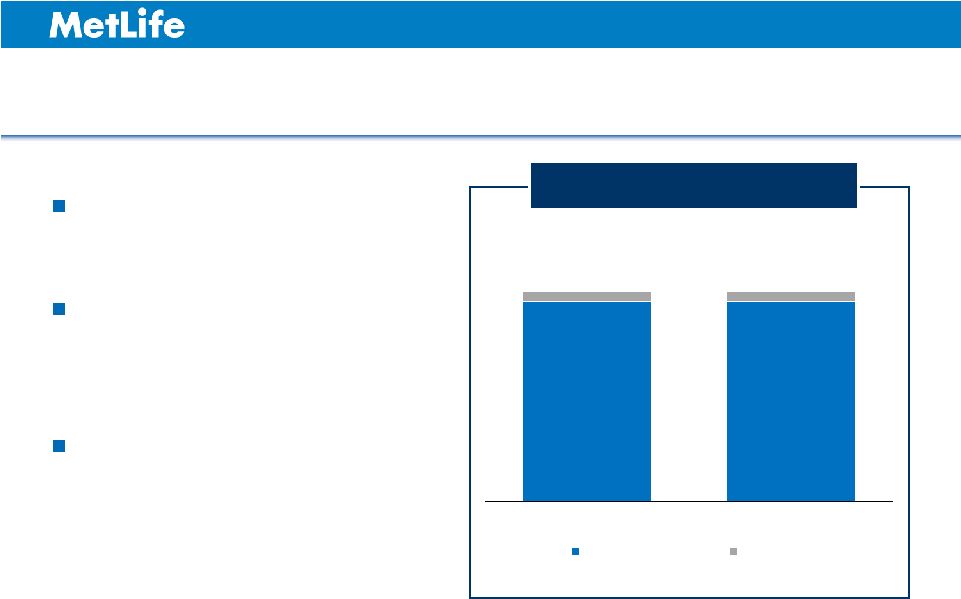 2013 Operating Expense Ratio
Expense discipline continues
Maintaining focus on Alico
integration
Pension/PRB cost has a
negative impact of $90 million
2012E
2013P
Excl. Pension/PRB
Pension/PRB
Operating Expense Ratio
23.6% -
24.5%
23.9% -
24.1%
22.5% -
23.4%
22.9% -
23.1%
42
See “Explanatory Note on Non-GAAP Financial Information” elsewhere in this
Appendix. |
 |
